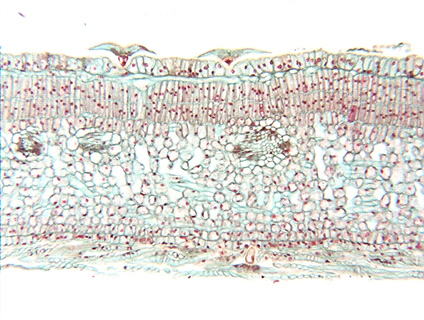 Fig.
10.4-5. Low magnification view of olive peltate trichomes. The upper
epidermis has two peltate trichomes that were cut near their center, so at least
part of the stalk of each is visible. On the lower epidermis there are the tops
of numerous peltate trichomes, but only one has its stalk visible. If you were
to look at this lower epidermis with a dissecting microscope or SEM, it would be
covered with an abundance of overlapping disks. A
dense covering of peltate trichomes have many effects on the biology of a leaf:
they retain water by inhibiting air movement near the stomata; they make it
difficult for many animals to walk on the leaf, and most fungal spores would
land on these trichomes, far away from the living cells of the leaf (the
trichomes of this leaf were alive when this material was collected and fixed,
but most trichomes die soon after they are formed).
Fig.
10.4-5. Low magnification view of olive peltate trichomes. The upper
epidermis has two peltate trichomes that were cut near their center, so at least
part of the stalk of each is visible. On the lower epidermis there are the tops
of numerous peltate trichomes, but only one has its stalk visible. If you were
to look at this lower epidermis with a dissecting microscope or SEM, it would be
covered with an abundance of overlapping disks. A
dense covering of peltate trichomes have many effects on the biology of a leaf:
they retain water by inhibiting air movement near the stomata; they make it
difficult for many animals to walk on the leaf, and most fungal spores would
land on these trichomes, far away from the living cells of the leaf (the
trichomes of this leaf were alive when this material was collected and fixed,
but most trichomes die soon after they are formed).